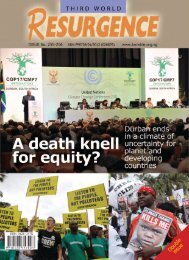Plantations, poverty and power - Critical Information Collective
Plantations, poverty and power - Critical Information Collective
Plantations, poverty and power - Critical Information Collective
Create successful ePaper yourself
Turn your PDF publications into a flip-book with our unique Google optimized e-Paper software.
119<br />
FAO’s guidelines recommend that governments should subsidise plantations, by “providing direct or<br />
indirect incentives to encourage long-term investment in planted forests that may be justified where<br />
society as a whole will benefit”.607 FAO provides no guidance on how to determine the interests of<br />
“society as a whole” or who should determine what those interests are. This is important. A group of<br />
farmers in rural areas will have a very different view of whether planting thous<strong>and</strong>s of hectares of<br />
industrial tree plantations benefits society as a whole to that of a Northern-based consultant keen to win<br />
new contracts for their company by ensuring the expansion of the pulp <strong>and</strong> paper industry.<br />
Having stated that governments should subsidise the establishment of plantations, FAO’s guidelines<br />
contradict themselves. Principle 6 of the guidelines is titled “Recognition of the role of the market”. This<br />
Principle states that: “Establishment <strong>and</strong> management of planted forests should be market- rather than<br />
production-driven, unless established for environmental, protective or civic reasons.”608 Clearly, any<br />
commercial company will justify their proposed (or existing) plantations on the basis that they are<br />
“market-driven”. But if plantations were really “market-driven”, why would there be a need for<br />
governments to provide subsidies<br />
Principle 7, “Recognition of social <strong>and</strong> cultural values”, asks governments to recognise “the local<br />
community values, customary rights, traditional knowledge, religious values <strong>and</strong> tenure of indigenous<br />
peoples <strong>and</strong> ethnic minorities in areas targeted for planted forest investments.” But FAO provides no<br />
advice on how governments are supposed to balance the conflicting dem<strong>and</strong>s of “market-driven”<br />
expansion of industrial tree plantations <strong>and</strong> local communities’ rights to decide their own future.<br />
FAO’s guidelines are in favour of establishing carbon markets to provide another subsidy for the<br />
establishment of industrial tree plantations. FAO encourages governments to recognise “the emerging<br />
carbon trade markets <strong>and</strong> the increased underst<strong>and</strong>ing of the role of afforestation <strong>and</strong> reforestation in<br />
providing carbon sinks to mitigate climate change, whether planted forests are for productive or<br />
protective functions.” The guidelines do not discuss the problems associated with all such carbon trade<br />
schemes, such as the impossibility of determining what would have happened if the plantation project did<br />
not go ahead. Or the complexity of calculating how much carbon is stored in soils <strong>and</strong> above ground<br />
biomass. Or the fact that if carbon is traded it allows the companies buying the carbon credits to continue<br />
polluting – thus avoiding addressing climate change. Or the fact that short rotation industrial tree<br />
plantations only store the carbon for a short period. If the wood from the plantations is converted to paper,<br />
this often has a short life <strong>and</strong> most of it ends up in l<strong>and</strong>fills where it rots <strong>and</strong> produces methane (a gas<br />
which is more than 20 times as potent a greenhouse gas as carbon dioxide). Or the fact that plantations<br />
might be cut down by local communities who want their l<strong>and</strong> back. Or that the plantations may be<br />
attacked by disease or fire. In each of these cases, any carbon that is stored in the plantation is released to<br />
the atmosphere.609<br />
Principle 9, on “Maintenance <strong>and</strong> conservation of environmental services”, confirms that “Planted forest<br />
607 FAO (2006) “Responsible management of planted forests: voluntary guidelines”, Planted Forests <strong>and</strong> Trees Working<br />
Paper 37/E, UN Food <strong>and</strong> Agriculture Organisation, page 13. http://www.fao.org/docrep/009/j9256e/J9256E00.htm<br />
608 FAO (2006) “Responsible management of planted forests: voluntary guidelines”, Planted Forests <strong>and</strong> Trees Working<br />
Paper 37/E, UN Food <strong>and</strong> Agriculture Organisation, page 13. http://www.fao.org/docrep/009/j9256e/J9256E00.htm<br />
609 See Larry Lohmann (editor) (2006) “Carbon Trading: A <strong>Critical</strong> Conversation on Climate Change, Privatisation <strong>and</strong><br />
Power”, Dag Hammarskjold Foundation, Durban Group for Climate Justice <strong>and</strong> The Corner House, October 2006.<br />
http://www.thecornerhouse.org.uk/summary.shtmlx=544225















